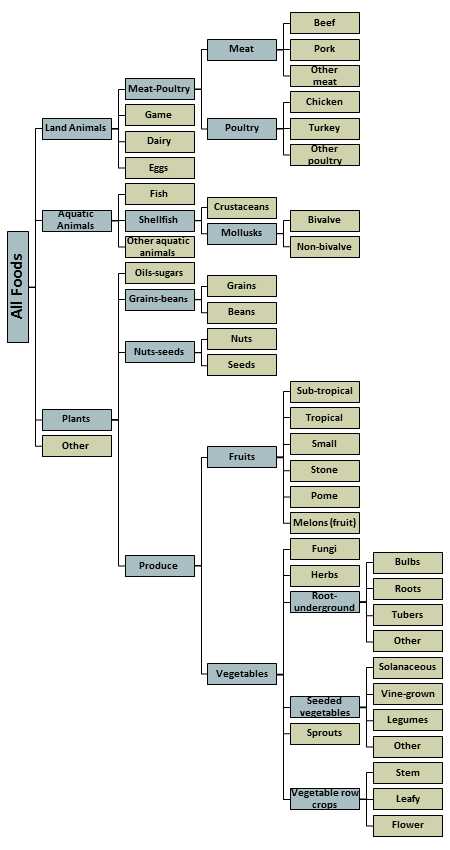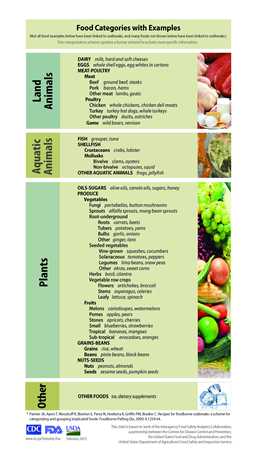Completed Projects
Developed a shared understanding and statement of needs for foodborne illness source attribution
-
Objective: Through a series of discussions, accomplish the following goals:
- Reach a shared understanding among the three agencies of historic and current methods and data sources used for foodborne illness source attribution.
- Identify short- and long-term needs of IFSAC partners.
- Review, compare, and select method(s) for estimating foodborne illness source attribution in the short term.
- Develop plans for applying the method(s) to each prioritized pathogen.
- Project Results: During an April 2011 workshop held by the IFSAC Steering Committee and Technical Workgroup, team members developed a shared statement of needs and identified several analytic projects.
Improved food categorization scheme for attributing outbreaks and related illnesses to foods
-
Objective: To expand the food categorization scheme used by CDC to classify foods implicated in foodborne disease outbreaks to include:
- More specific food categories.
- Useful categories for regulatory agencies and stakeholders.
-
Project Results: Expanded the previously used food categorization scheme to include more specific food categories that:
- Are more botanically correct.
- Better reflect production practices and postharvest handling systems.
- More readily distinguish FDA- and FSIS- regulated products.
After the new categorization scheme was determined, the IFSAC team assigned all applicable food items in the CDC outbreak surveillance database to these new categories. Additionally, the IFSAC team developed a food glossary with examples of foods for each food category.
The revised scheme has six distinct levels to which foods can be assigned, depending upon the type of food. First, foods are assigned to one of four food groups (aquatic animals, land animals, plants, and other). Food groups include increasingly specific food categories; dairy, eggs, meat and poultry, and game are in the land animal food group, and the category meat and poultry is further subdivided into more specific categories of meat (beef, pork, other meat) and poultry (chicken, turkey, other poultry). Finally (not shown in graphic below), foods are differentiated by differences in food processing (such as pasteurized fluid dairy products, unpasteurized fluid dairy products, pasteurized solid and semi-solid dairy products, and unpasteurized solid and semi-solid dairy products.

Food categorization scheme depicting food categories with examples. Click for larger view.

Infographic depicting food categories with examples. Click for larger view [PDF – 1 page].
The new food categorization scheme was shared during a June 2013 webinar, available on our Activities and Events page.
Determined sources of uncertainty and variability in estimated attribution fractions
Objective: Determine the best approach to estimate source attribution using outbreak surveillance data while exploring the uncertainties and variability associated with computing attribution estimates using outbreak data.
Project Results: There are several sources of uncertainty associated with using foodborne disease outbreak data to estimate the proportions of illnesses caused by the pathogens Salmonella, Listeria monocytogenes, Campylobacter, and E. coli O157:H7 in the population. A review of the literature confirmed that attribution estimates derived from outbreak data can vary depending on:
- Unit of analysis (i.e., outbreak counts or outbreak-associated illnesses).
- Food classification scheme used to categorize foods implicated in outbreaks.
- Time period of analysis.
- Amount of missing data and the number of foods with unknown contaminated ingredients.
Additionally, attribution estimates generated from outbreak data are different from those calculated using data from other surveillance populations. These differences highlight another important source of uncertainty regarding the representativeness of outbreaks of the foods and pathogens causing foodborne illness in the general population. These findings have provided the foundation for pursuing a tri-agency approach to estimating foodborne illness source attribution using outbreak data.
Estimated the proportion of SE illnesses attributable to shell eggs and other food categories
- Objective: To help assess the public health impact of the Egg Rule, an FDA regulation enacted in 2010 (“the Egg Rule”), this project sought to determine the proportion of illnesses attributable to shell eggs and other common sources before implementation of the rule.
- Project Results: Developed a new method to estimate the proportion of foodborne Salmonella serotype Enteritidis (SE) illnesses attributable to shell eggs and other major food commodity reservoirs of SE during the baseline period (2007-2009).
Among the included sources, shell eggs were estimated to be responsible for the highest proportion of foodborne SE infections (40%; 95% CI: 30-51%) during the baseline period (2007-2009). This estimate is required for the Department of Health and Human Services’ Agency Priority goal, which is part of a government-wide Office of Management and Budget (OMB) performance management effort. This estimate will help improve our ability to assess the public health impact of the Egg Rule over time.
Compared characteristics of sporadic and outbreak-associated foodborne illnesses
- Objective: Investigate the representativeness of U.S. 2004-2011 outbreak illness data for making important inferences regarding the attribution for sporadic illnesses
- Project Results: Initial findings were shared during a January 2014 webinar, available on our Activities and Events page. Final results were published in 2016 as a journal article, available on our IFSAC Publications page
Applied models to estimate number of illnesses associated with foods and Salmonella subtypes
- Objective: Estimate the burden of human Salmonella infections attributable to specific food categories.
- Project Results: Findings were shared during a July 2015 presentation at the IAFP (International Association for Food Protection) Conference. A draft manuscript describing this completed work is in development.
Improved analyses of outbreak data used to assign implicated foods to food categories
- Objective: Determine analytic approach for attributing foodborne disease outbreaks to a single food source.
- Project Results: New food categories developed under this project are now incorporated into annual summaries of foodborne outbreaks and illnesses
Communicated IFSAC activities and events to the public
- Objective: Communicating IFSAC activities, food safety interventions, and policies to the public and its stakeholders.
-
Project Results: The IFSAC Communication Project entailed several deliverables:
- First Public Meeting in January 2012
- First webinar in June 2013 (“Improving the Categories Used to Classify Foods Implicated in Outbreaks.”)
- Second webinar in January 2014 (“Are Outbreak Illnesses Representative of Sporadic Illnesses?”)
- Development and launch of an IFSAC webpage in May 2014
- Second Public Meeting in February 2015
- Development of tri-agency approved press releases, Federal Register Notices (FRN), Constituent Updates, and a Key Messages document, among other communication documents.
- Establishment of a permanent IFSAC Communication Workgroup; tasked with coordinating all IFSAC communication efforts
Developed a method for food source attribution for four bacteria using outbreak data
- Objective: Develop tri-agency outbreak-derived food source attribution fractions with quantified uncertainty bounds to use when attributing estimates for Salmonella, E. coli O157:H7, Listeria monocytogenes and Campylobacter..
- Project Results: A final report was publicly released in 2015, available on our IFSAC Publications page. Results were also shared during a February 2015 Public Meeting in Washington, DC. A transcript and recording of this event is available on our Activities and Events page.
- Page last reviewed: February 13, 2017
- Page last updated: February 13, 2017
- Content source:


 ShareCompartir
ShareCompartir